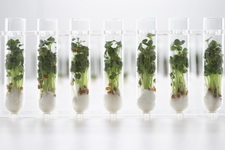
Supercomputer Unlocks the Secrets of Plant Cells for More Resilient Crops
May 27, 2015| |
 Scientists from the University of Melbourne and Queensland and IBM Research have been able to model the structure and dynamics of cellulose at the molecular level. Dr. Monika Doblin from the University of Melbourne said cellulose is a vital part of plant structure, but its synthesis is yet to be fully understood. "It's difficult to work on cellulose synthesis in vitro because once plant cells are broken open, most of the enzyme activity is lost, so we needed to find other approaches to study how it is made," Dr. Doblin said.
Scientists from the University of Melbourne and Queensland and IBM Research have been able to model the structure and dynamics of cellulose at the molecular level. Dr. Monika Doblin from the University of Melbourne said cellulose is a vital part of plant structure, but its synthesis is yet to be fully understood. "It's difficult to work on cellulose synthesis in vitro because once plant cells are broken open, most of the enzyme activity is lost, so we needed to find other approaches to study how it is made," Dr. Doblin said.
Using IBM's Blue Gene/Q supercomputer known as Avoca, the scientists were able to perform the quadrillions of calculations required to model the motions of cellulose atoms. The results show that within the cellulose structure, there are between 18 and 24 chains present within an elementary microfibril, much less than the 36 chains that had previously been assumed.
These insights could pave the way for more disease resistant varieties of crops and increase the sustainability of the pulp, paper, and fiber industry. According to IBM researcher Dr. Daniel Oehme, they are exploring ways to manipulate the composition of the wall to make it more resistant to diseases.
For more details, read the news release at the University of Melbourne website.
| |
Biotech Updates is a weekly newsletter of ISAAA, a not-for-profit organization. It is distributed for free to over 22,000 subscribers worldwide to inform them about the key developments in biosciences, especially in biotechnology. Your support will help us in our mission to feed the world with knowledge. You can help by donating as little as $10.
-
See more articles:
-
News from Around the World
- UN Report Shows Projected Results for MDG Health Targets by Year End
- Mozambique Steps Forward in Achieving Food Security
- Genes Involved in Giant Tomato Fruit Size Revealed
- USDA APHIS Releases Draft Documents for GE Corn and Cotton for Public Review
- Researchers Produce Most Complete Functional Map of a Sucrose-Degrading Enzyme Family
- IRRI Study Shows Rice Preferences of South Asians
- Supercomputer Unlocks the Secrets of Plant Cells for More Resilient Crops
- CAS Researchers Clone Heat Tolerance Gene from African Rice Variety
- EFSA's GMO Network Discuss Risk Assessment of GMOs
- Scientists Discover Plant Receptors with Built-in Decoys that Make Pathogens Betray Themselves
-
Research Highlights
- Modifying RNA Extraction Methods for Better RNA Quality
- A Genetic Device to Degrade Targeted DNA in GMO Developed
-
Beyond Crop Biotech
- NAST Philippines Discusses Livestock Nutritional Biotech
- Sex Determining Genes in Mosquitoes Could Help Fight Dengue Fever
- Screening Genetic Defects in Domestic Livestock Tackled in NAST PHL Roundtable Discussion
-
Read the latest: - Biotech Updates (December 10, 2025)
- Gene Editing Supplement (November 26, 2025)
- Gene Drive Supplement (February 22, 2023)
-
Subscribe to BU: - Share
- Tweet
